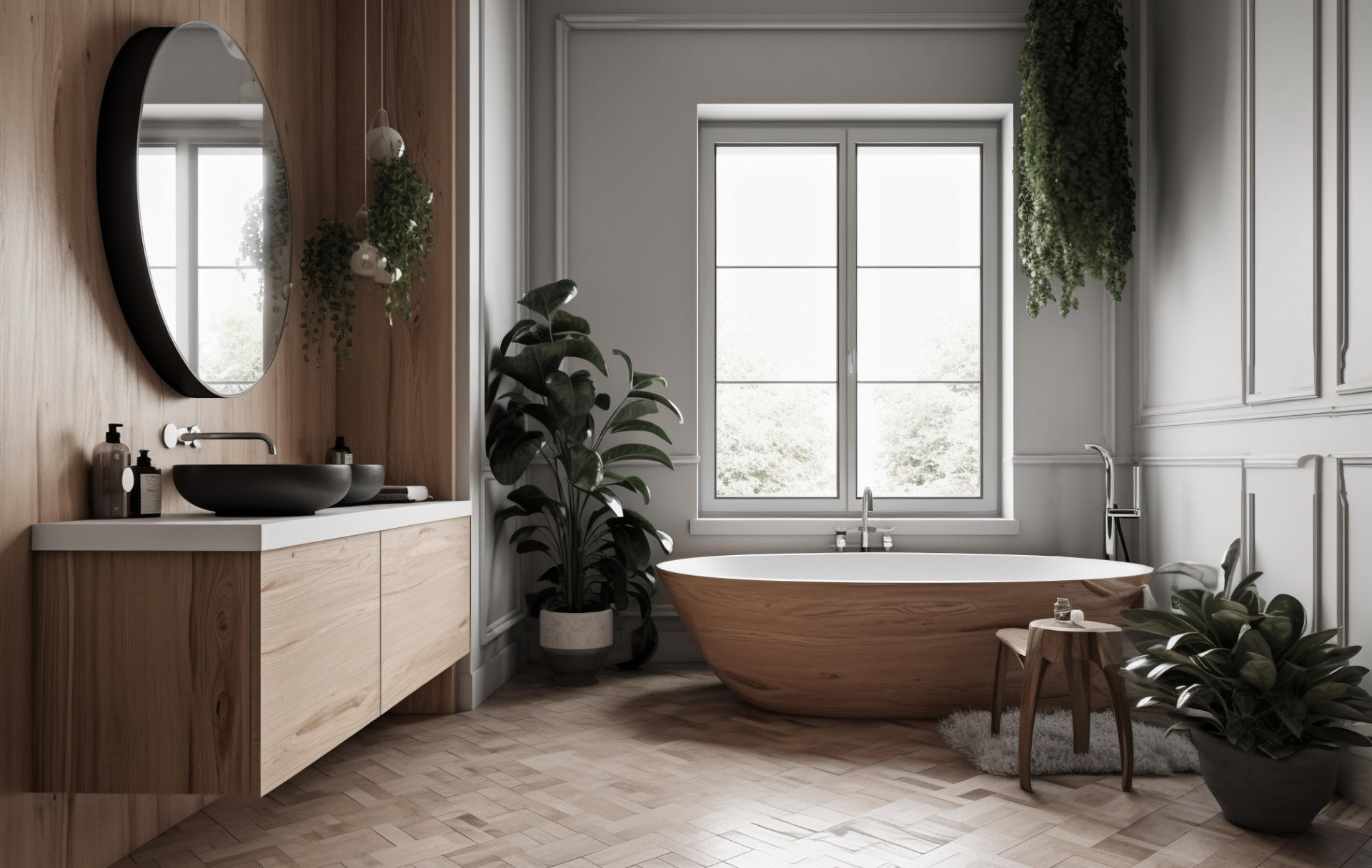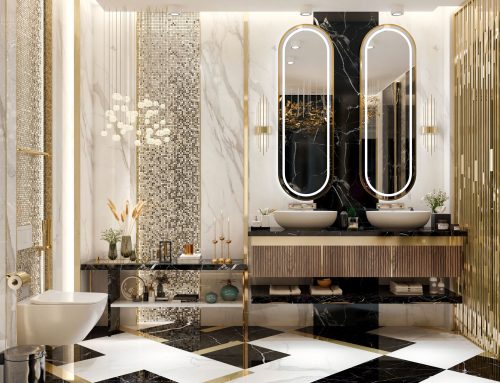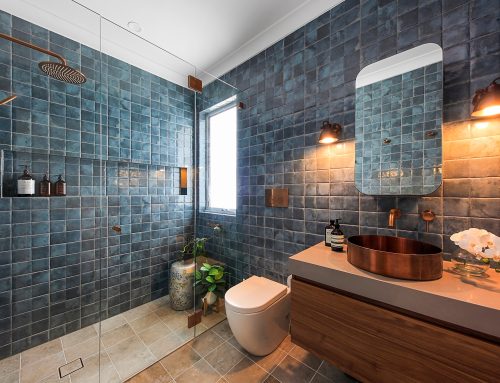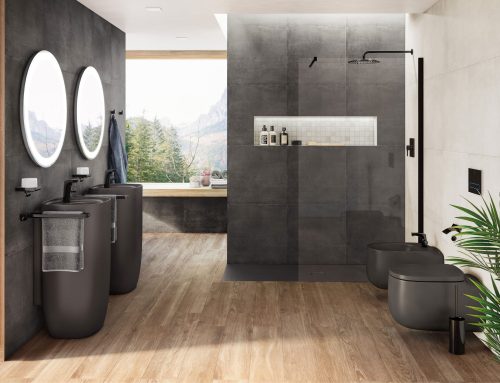Creating a sustainable and eco-friendly bathroom involves more than just selecting aesthetically pleasing fixtures and finishes; it requires a holistic approach that considers the environmental impact of every aspect of the design, from the materials used to the water and energy consumed. By incorporating environmentally friendly materials, water-saving fixtures, and energy-efficient lighting, you can create a bathroom that is not only beautiful but also kind to the planet. This comprehensive guide explores the key components of sustainable bathroom design and provides practical tips for creating a green and efficient space.
The Importance of Sustainable Design
Sustainable design focuses on reducing the environmental impact of buildings and interiors by using resources more efficiently and choosing materials and practices that are less harmful to the environment. In the context of bathroom design, this means selecting eco-friendly materials, conserving water, and using energy wisely. The benefits of sustainable design extend beyond environmental protection; they include promoting health and well-being through non-toxic materials, cost savings from reduced utility bills, and increased home value by appealing to environmentally conscious buyers.
Environmentally Friendly Materials
Choosing environmentally friendly materials for your bathroom can significantly reduce its environmental impact. Look for materials that are renewable, recycled, or sustainably sourced, and that have a low environmental footprint throughout their lifecycle.
- Sustainable Flooring Options: Bamboo and cork are excellent choices for bathroom flooring. Bamboo is a fast-growing, renewable resource that is durable and water-resistant, available in various finishes to suit different design styles. Cork, harvested from the bark of the cork oak tree, regenerates, making it a renewable resource. It is soft, warm, and resistant to mold and mildew. Recycled tiles made from glass, ceramic, or porcelain are also sustainable options, as are linoleum floors made from natural materials like linseed oil, wood flour, and jute.
- Eco-Friendly Wall and Countertop Materials: Recycled glass countertops, sustainable wood certified by the Forest Stewardship Council (FSC), and recycled paper composite are great alternatives to traditional materials. Natural plasters like clay and lime offer a beautiful, textured finish and help regulate indoor humidity.
- Low-VOC Paints and Finishes: Using low-VOC and zero-VOC products for paints and finishes reduces indoor air pollution and health risks. Natural oils, waxes, and water-based finishes are excellent for sealing and protecting wood and other surfaces without harmful chemicals.
- Recycled and Repurposed Materials: Incorporating salvaged wood, recycled metal, and repurposed items like antique dressers or vintage tiles can add unique character to your bathroom while reducing the demand for new materials.
Water-Saving Fixtures
Water conservation is a critical aspect of sustainable bathroom design. By choosing water-saving fixtures, you can significantly reduce water usage and lower your utility bills.
- Low-Flow Toilets: Dual-flush toilets allow you to use less water for each flush by providing two flush options—one for liquid waste and one for solid waste. Pressure-assisted toilets use pressurized air to create a powerful flush with less water, making them more efficient than traditional gravity-flush toilets.
- Water-Efficient Faucets: Faucet aerators mix air with water to reduce flow without compromising water pressure, and low-flow faucets are designed to use less water while maintaining adequate pressure. Touchless faucets use sensors to turn on and off, reducing water waste and improving hygiene.
- Water-Saving Showerheads: Low-flow showerheads provide a satisfying shower experience while using less water. Aerating showerheads mix air with water to reduce flow while maintaining pressure, offering a soft, mist-like spray. Handheld showerheads allow for more targeted use, reducing water waste and adding convenience.
- Greywater Systems: These systems collect and recycle water from sinks, showers, and baths for use in toilets and irrigation, significantly reducing overall water usage. Simple greywater systems collect greywater in a tank and pump it to toilets or irrigation systems, while advanced systems filter and treat greywater before reuse.
Energy-Efficient Lighting
Energy-efficient lighting reduces electricity consumption and lowers utility bills. By choosing the right lighting options, you can create a beautiful and sustainable bathroom.
- LED Lighting: LED lights are highly energy-efficient, using up to 80% less energy than traditional incandescent bulbs. They have a longer lifespan, reducing the need for frequent replacements. LEDs come in various forms, including bulbs, strips, and integrated fixtures, suitable for task, ambient, and accent lighting. Dimmable LEDs allow you to adjust the brightness to suit your needs and mood, creating a relaxing atmosphere while saving energy.
- Natural Light: Maximizing natural light can reduce the need for artificial lighting. Skylights, solar tubes, and large windows can increase natural light in your bathroom. Energy-efficient skylights with double glazing and low-emissivity (low-E) coatings, as well as frosted or textured glass for privacy, are excellent choices.
- Motion Sensors and Timers: Motion sensors automatically turn lights on and off when you enter or leave the room, reducing energy waste. Light timers can be set to turn lights on and off at specific times, ensuring they are not left on unnecessarily. Smart lighting systems, including smart bulbs and switches, can be controlled via smartphone apps or voice assistants, offering convenience and energy savings.
Sustainable Design Principles
In addition to choosing eco-friendly materials and fixtures, incorporating sustainable design principles can further enhance your bathroom renovation.
- Passive Solar Design: Position your bathroom to take advantage of natural sunlight. South-facing windows can provide ample light and warmth, reducing the need for artificial lighting and heating. Materials with high thermal mass, like stone or concrete, can absorb and store heat, helping to regulate indoor temperatures.
- Water Heating: Solar water heaters use the sun’s energy to heat water, reducing reliance on fossil fuels. Tankless water heaters heat water only when needed, making them more energy-efficient than traditional storage tank heaters. Insulating hot water pipes can reduce heat loss and improve energy efficiency.
- Ventilation: Proper ventilation is essential for maintaining good indoor air quality and preventing mold and mildew growth. Energy recovery ventilators (ERVs) exchange stale indoor air with fresh outdoor air while recovering heat and humidity. Energy-efficient exhaust fans with the ENERGY STAR label also help remove moisture and odors from the bathroom.
- Sustainable Plumbing: Choose durable, non-toxic materials like copper or PEX for pipes and fittings. Leak detection systems can prevent water waste and damage by identifying and addressing leaks quickly.
- Waste Reduction: Set up a recycling system in your bathroom to separate recyclables from trash and encourage composting organic waste, such as hair and nail clippings, to reduce landfill waste.
Case Studies of Sustainable Bathroom Designs
- The Green Oasis: This bathroom features countertops made from recycled glass and concrete, reclaimed wood for the vanity and shelving, dual-flush toilets, low-flow faucets, aerating showerheads, LED lights, skylights, and motion sensors. Natural elements like stone and plants create a calming, spa-like atmosphere.
- The Eco-Friendly Family Bathroom: Designed for a busy family, this bathroom combines practicality with sustainability. It includes cork flooring, low-VOC paints and finishes, a greywater system, and smart lighting. These features ensure durability, better indoor air quality, water conservation, and efficient lighting.
- The Urban Eco Retreat: This compact bathroom in a city apartment demonstrates that sustainable design can be stylish and functional. It features recycled ceramic tiles, a tankless water heater, a low-flow showerhead and faucet, an energy recovery ventilator, and space-saving solutions like a wall-mounted toilet and compact vanity.
Conclusion
Creating a sustainable and eco-friendly bathroom involves thoughtful planning and the right choices in materials, fixtures, and design principles. By incorporating environmentally friendly materials, water-saving fixtures, and energy-efficient lighting, you can reduce your environmental impact and enjoy a beautiful, functional, and efficient space. Whether you’re renovating an existing bathroom or designing a new one, these sustainable design strategies can help you create a bathroom that is both stylish and kind to the planet. Every small step towards sustainability makes a significant difference, contributing to a healthier home and a more sustainable future for all.
A division of Ross Brothers Construction Click here to see all our completed projects




